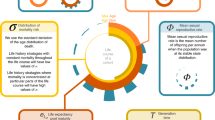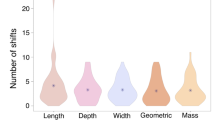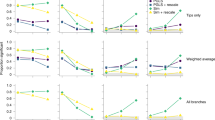Abstract
Species’ life histories are often classified on a continuum from “fast” to “slow”, yet there is no consistently used definition of this continuum. For example, some researchers include body mass as one of the traits defining the continuum, others factor it out by analysing body-mass residuals, a third group performs both of these analyses and uses the terms “fast” and “slow” in both ways, while still others do not mention body mass at all. Our analysis of European and North American freshwater fish, mammals, and birds (N = 2,288 species) shows the fundamental differences between life-history patterns of raw data and of body-mass residuals. Specifically, in fish and mammals, the number of traits defining the continuum decreases if body-mass residuals are analysed. In birds, the continuum is defined by a different set of traits if body mass is factored out. Our study also exposes important dissimilarities among the three taxonomic groups analysed. For example, while mammals and birds with a “slow” life history have a low fecundity, the opposite is true for fish. We conclude that our understanding of life histories will improve if differences between patterns of raw data and of body-mass residuals are acknowledged, as well as differences among taxonomic groups, instead of using the “fast–slow continuum” too indiscriminately for any covarying traits that appear to suit the idea.




Similar content being viewed by others
References
Banavar JR, Damuth J, Maritan A, Rinaldo A (2002) Supply-demand balance and metabolic scaling. Proc Natl Acad Sci USA 99:10506–10509. doi:10.1073/pnas.162216899
Bennett PM, Owens IPF (2002) Evolutionary ecology of birds: life histories, mating systems and extinction. Oxford University Press, Oxford
Bielby J, Mace GM, Bininda-Emonds ORP, Cardillo M, Gittleman JL, Jones KE et al (2007) The fast–slow continuum in mammalian life history: an empirical re-evaluation. Am Nat 169:748–757. doi:10.1086/516847
Blackburn TM (1991) Evidence for a ‘fast–slow’ continuum of life-history traits among parasitoid Hymenoptera. Funct Ecol 5:65–74. doi:10.2307/2389556
Brommer JE (2000) The evolution of fitness in life-history theory. Biol Rev Camb Philos Soc 75:377–404. doi:10.1017/S000632310000551X
Brown JH, Sibly RM (2006) Life-history evolution under a production constraint. Proc Natl Acad Sci USA 103:17595–17599. doi:10.1073/pnas.0608522103
Brown JH, Gillooly JF, Allen AP, Savage VM, West GB (2004) Toward a metabolic theory of ecology. Ecology 85:1771–1789. doi:10.1890/03-9000
Cardillo M, Mace GM, Jones KE, Bielby J, Bininda-Emonds ORP, Sechrest W et al (2005) Multiple causes of high extinction risk in large mammal species. Science 309:1239–1241. doi:10.1126/science.1116030
Charnov EL (1991) Evolution of life history variation among female mammals. Proc Natl Acad Sci USA 88:1134–1137. doi:10.1073/pnas.88.4.1134
Darveau C-A, Suarez RK, Andrews RD, Hochachka PW (2002) Allometric cascade as a unifying principle of body mass effects on metabolism. Nature 417:166–170. doi:10.1038/417166a
Demetrius L (2006) The origin of allometric scaling laws in biology. J Theor Biol 243:455–467. doi:10.1016/j.jtbi.2006.05.031
Duarte CM, Alcaraz M (1989) To produce many small or few large eggs: a size-independent reproductive tactic of fish. Oecologia 80:401–404. doi:10.1007/BF00379043
Elgar MA (1990) Evolutionary compromise between a few large and many small eggs: comparative evidence in teleost fish. Oikos 59:283–287. doi:10.2307/3545546
Felsenstein J (1985) Phylogenies and the comparative method. Am Nat 125:1–15. doi:10.1086/284325
Fisher DO, Owens IPF, Johnson CN (2001) The ecological basis of life history variation in marsupials. Ecology 82:3531–3540
Franco M, Silvertown J (1996) Life history variation in plants: an exploration of the fast–slow continuum hypothesis. Philos Trans R Soc Lond B Biol Sci 351:1341–1348. doi:10.1098/rstb.1996.0117
Gaillard J-M, Pontier D, Allainé D, Lebreton JD, Trouvilliez J, Clobert J (1989) An analysis of demographic tactics in birds and mammals. Oikos 56:59–76. doi:10.2307/3566088
Garland T Jr, Harvey PH, Ives AR (1992) Procedures for the analysis of comparative data using phylogenetically independent contrasts. Syst Biol 41:18–32. doi:10.2307/2992503
Garland T Jr, Bennett AF, Rezende EL (2005) Phylogenetic approaches in comparative physiology. J Exp Biol 208:3015–3035. doi:10.1242/jeb.01745
Grime JP (1974) Vegetation classification by reference to strategies. Nature 250:26–31. doi:10.1038/250026a0
Heppell SS, Caswell H, Crowder LB (2000) Life histories and elasticity patterns: perturbation analysis for species with minimal demographic data. Ecology 81:654–665
Jeschke JM, Strayer DL (2005) Invasion success of vertebrates in Europe and North America. Proc Natl Acad Sci USA 102:7198–7202. doi:10.1073/pnas.0501271102
Jeschke JM, Strayer DL (2006) Determinants of vertebrate invasion success in Europe and North America. Glob Change Biol 12:1608–1619. doi:10.1111/j.1365-2486.2006.01213.x
Jeschke JM, Gabriel W, Kokko H (in press) Population dynamics: r-strategists/K-strategists. In: Jørgensen SE (ed) Encyclopedia of ecology. Elsevier, Amsterdam
Jones KE, MacLarnon A (2001) Bat life histories: testing models of mammalian life-history evolution. Evol Ecol Res 3:465–476
Kokko H, López-Sepulcre A (2007) The ecogenetic link between demography and evolution: can we bridge the gap between theory and data? Ecol Lett 10:773–782. doi:10.1111/j.1461-0248.2007.01086.x
Kooijman SALM (2000) Dynamic energy and mass budgets in biological systems. Cambridge University Press, Cambridge
Kozłowski J, Konarzewski M, Gawelczyk AT (2003) Intraspecific body size optimization produces interspecific allometries. In: Blackburn TM, Gaston KJ (eds) Macroecology: concepts and consequences. Blackwell, Oxford, pp 299–320
Loehle C (1988) Tree life history strategies: the role of defenses. Can J Res 18:209–222
MacArthur RH (1962) Some generalized theorems of natural selection. Proc Natl Acad Sci USA 48:1893–1897. doi:10.1073/pnas.48.11.1893
MacArthur RH, Wilson EO (1967) The theory of island biogeography. Princeton University Press, Princeton
Mayhew PJ (2006) Discovering evolutionary ecology. Oxford University Press, Oxford
Maddison WP, Maddison DR (2004) Mesquite: a modular system for evolutionary analysis. Version 1.05. http://mesquiteproject.org
Midford PE, Garland T Jr, Maddison WP (2005) PDAP package of Mesquite, version 1.06. http://mesquiteproject.org
Mylius SD, Diekmann O (1995) On evolutionarily stable life histories, optimization and the need to be specific about density dependence. Oikos 74:218–224. doi:10.2307/3545651
Nowak RM (1991) Walker’s mammals of the world, 5th edn. Johns Hopkins University Press, Baltimore
Oli MK (2004) The fast–slow continuum and mammalian life-history patterns: an empirical evaluation. Basic Appl Ecol 5:449–463. doi:10.1016/j.baae.2004.06.002
Pagel MD (1992) A method for the analysis of comparative data. J Theor Biol 156:431–442. doi:10.1016/S0022-5193(05)80637-X
Pianka ER (1970) On r- and K-selection. Am Nat 104:592–597. doi:10.1086/282697
Read AF, Harvey PH (1989) Life history differences among the eutherian radiation. J Zool (Lond) 219:329–353
Reynolds JD (2003) Life histories and extinction risk. In: Blackburn TM, Gaston KJ (eds) Macroecology: concepts and consequences. Blackwell, Oxford, pp 195–217
Reznick D, Bryant MJ, Bashey F (2002) r- and K-selection revisited: the role of population regulation in life-history evolution. Ecology 83:1509–1520
Ricklefs RE (2000) Density dependence, evolutionary optimization, and the diversification of avian life histories. Condor 102:9–22. doi:10.1650/0010-5422(2000)102[0009:DDEOAT]2.0.CO;2
Roff DA (2002) Life history evolution. Sinauer, Sunderland
Rueffler C, Egas M, Metz JAJ (2006) Evolutionary predictions should be based on individual-level traits. Am Nat 168:E148–E162. doi:10.1086/508618
Rushton JP (1988) Race differences in behaviour: a review and evolutionary analysis. Pers Individ Dif 9:1009–1024. doi:10.1016/0191-8869(88)90135-3
Sæther B-E (1987) The influence of body weight on the covariation between reproductive traits in European birds. Oikos 48:79–88. doi:10.2307/3565691
Sæther B-E, Bakke Ø (2000) Avian life history variation and contribution of demographic traits to the population growth rate. Ecology 81:642–653
Sæther B-E, Ringsby TH, Røskaft E (1996) Life history variation, population processes and priorities in species conservation: towards a reunion of research paradigms. Oikos 77:217–226. doi:10.2307/3546060
Stearns SC (1977) The evolution of life history traits: a critique of the theory and a review of the data. Annu Rev Ecol Syst 8:145–171. doi:10.1146/annurev.es.08.110177.001045
Stearns SC (1983) The influence of size and phylogeny on patterns of covariation among life-history traits in the mammals. Oikos 41:173–187. doi:10.2307/3544261
Stearns SC (1984) The effects of size and phylogeny on patterns of covariation in the life history traits of lizards and snakes. Am Nat 123:56–72. doi:10.1086/284186
Stearns SC (1992) The evolution of life histories. Oxford University Press, Oxford
Winemiller KO (1992) Life-history strategies and the effectiveness of sexual selection. Oikos 63:318–327. doi:10.2307/3545395
Acknowledgements
We thank the Academy of Finland for funding and Tim Benton, Jon Brommer, Wilfried Gabriel, Stephen Stearns, and anonymous reviewers for comments. Bernt-Erik Sæther provided information on the origin of the term “fast–slow continuum”. The PanTHERIA Project (Cardillo et al. 2005; Bielby et al. 2007) provided the mammal phylogeny included in Jeschke and Strayer (2006).
Author information
Authors and Affiliations
Corresponding author
Electronic supplementary material
Rights and permissions
About this article
Cite this article
Jeschke, J.M., Kokko, H. The roles of body size and phylogeny in fast and slow life histories. Evol Ecol 23, 867–878 (2009). https://doi.org/10.1007/s10682-008-9276-y
Received:
Accepted:
Published:
Issue Date:
DOI: https://doi.org/10.1007/s10682-008-9276-y




